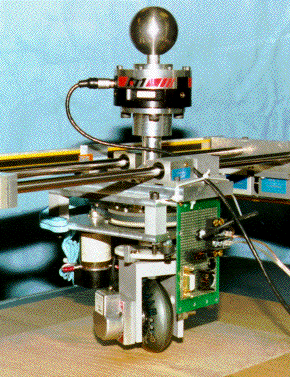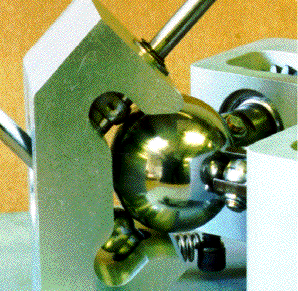
Figure 1: Big color photo, Big b+w photo.
Michael Peshkin
J. Edward Colgate
Northwestern University
Cobots are a new type of robotic device, intended for direct collaboration with a human operator within a shared workspace.
Cobots are physically passive. Their purpose is not to enhance human strength, but to provide virtual "guiding" surfaces. The human part of the team supplies all motive power, while the cobot interfaces to a computer. Thus cobots are potentially well-suited to safety-critical tasks such as computer assisted surgery, or to tasks where sufficiently strong conventional robots would be too dangerous for direct contact with a person, such as automobile assembly.
When conventional robots are used to enforce virtual surfaces, the robot's joint motors must resist operator and payload forces that would violate the constraints. Cobots, by comparison, have no joint actuators. Instead they employ nonholonomic joints. These joints redirect disallowed motions, rather than fight them.
The simplest cobot, which nevertheless exhibits all essential behaviors, is the unicycle cobot shown in figure 1. It has a two-dimensional (planar) workspace. Constraint surfaces, defined in software, delimit excluded areas of the plane. The Cartesian rails serve only to keep the unicycle upright, and are not needed in the designs which will follow.

Figure 1: Big color photo, Big
b+w photo.
The cobot mechanism consists of a free-rolling wheel in contact with a working surface. The wheel's rolling velocity is monitored by an encoder, but it is not driven by a motor.
The motor in the figure simply steers the wheel. No amount of malevolent steering by the control computer can cause the cobot to move on its own! Only the operator can cause it to move, by applying forces to the handle. A force sensor monitors these user forces.
The unicycle cobot displays two essential behaviors: virtual caster, and virtual wall. Virtual caster mode is invoked when the cobot's position in its planar workspace is away from all defined constraint surfaces. The cobot should therefore permit any motion that the user attempts to impart. To do this, the steering angle of the wheel is servo-controlled such that user forces perpendicular to the wheel's rolling direction are nulled. The behavior is similar to that of a caster wheel on a rolling item of furniture, though there is no physical caster at all.
When the user brings the cobot's position in the plane to a place where a constraint surface is defined, control of the steering angle changes over to virtual wall mode. The wheel is steered such that its rolling direction becomes tangent to the constraint surface, and this tangency is maintained as the user moves the cobot in "virtual contact" with the constraint surface. The user perceives contact with a hard frictionless constraint surface. In practice the illusion is convincing.
Virtual wall mode is ended when the measured user forces are found to be directed away from the constraint surface, at which point virtual caster mode resumes.
Figure 2 shows a "tricycle" cobot with a three-dimensional workspace. Now virtual constraint surfaces can be defined in terms of orientation as well as position within the plane.

Figure 2: Big color photo,
Big b+w photo.
Three wheels are one too many, and the tricycle cobot can brake by intentionally misaligning its wheels, such that their three axes do not coincide at a common center of rotation.
The device can also display the two modes mentioned above: virtual caster mode in which the wheels are steered so as to comply with user forces; and virtual wall mode in which the wheels are steered tangent to a software-defined constraint surface, resisting user forces.
A rail system is no longer needed: this cobot stands on its own.
A rolling wheel, which creates a nonholonomic constraint, is essential to the cobots above. Each rolling wheel removes a degree of freedom from the basic mechanism. For instance, the tricycle's three degrees of planar freedom are reduced to zero by its three wheels.
In cobots, servo-control is used to selectively add apparent degrees of freedom by steering the wheels, so that (in caster mode) the device appears to be unconstrained.
In contrast, conventional robots have multiple mechanical degrees of freedom, which may be selectively reduced through servo-control to create apparent constraints.
The cobot's low number of mechanical degrees of freedom (zero or one) give it the ability to passively redirect a user's attempted motion. For instance, when a user pushes the unicycle cobot against a virtual constraint, the cobot rolls tangent to the constraint instead. Since the constraint surface is mechanical in origin, it is inherently strong, stable, and smooth, yet no large motors are involved.
A conventional robot defending a constraint must actively oppose the user's force using servo-control and motors.
It is interesting to speculate about higher dimensional cobots, and other architectures, and especially about whether an "armlike" serial cobot with revolute joints is possible. Generalization is possible if we consider carefully the role of the nonholonomic device: the rolling wheel in the examples above.
The function of the rolling wheel is to couple a pair of translational velocities, constraining them mechanically to a particular ratio Vy/Vx = tan(alpha) This ratio is under computer control, via the motor that sets the wheel's steering angle alpha.
The nonholonomic device analogous to a rolling wheel, but for use in a revolute robot, would have to couple two angular velocities rather than two translational velocities. It would constrain them mechanically to a particular ratio w2/w1 = tan(a) where a, analogous to a steering angle, is controlled by a computer via a steering motor. This device would be used to couple two consecutive joints of a serial arm, in place of the actuators found at the joints of a conventional robot.

Figure 3: Big color photo
A suitable nonholonomic device is shown in figure 3. The rotation of the two shafts on the left are constrained to be in a proportion dictated by the angle set on the steering rollers on the right . A three link "armlike" serial cobot would incorporate two such devices, one coupling the first joint to the second, and the other coupling the second joint to the third.
Other cobot kinematic architectures, control design, and experimental results may be found at the cobot web site: http://othello.mech.nwu.edu/~peshkin/cobot
Cobot group members at Northwestern University also include Witaya Wannasuphoprasit, Brent Gillespie, Julio Santos-Munne, Carl Moore, and Aaron Mills.
This work was supported by a grant from the General Motors Foundation. Additional support from the Whitaker Foundation and the National Science Foundation is gratefully acknowledged.